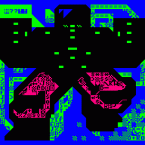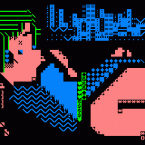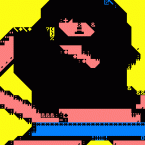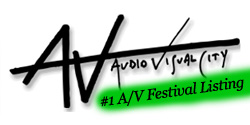Datastorm and the 8-bit scene
I’ve been meaning to write about the 8-bit scene for quite some time and recently something happened that gave me a very good reason to get it done.

Ok, forget what I wrote about street cred.
I have my roots back in the Amiga demo culture but saying that I was part of the scene would be to exaggerate. I was in a couple of demo groups but I didn’t really take part in any social events and my work was not spread to the rest of the world. I divided that part of my life to programming and breakdancing with the result of not being great at any of the two. It gained me enough street cred to avoid a beating and an understanding of programming that proved to be helpful later in life.
When Ilan Katin told me about the Datastorm party that was going on in Gothenburg parallel to Pixelvärk I got really excited. Datastorm is dedicated to the Commodore 64 and Amiga demo scenes. When we were done with the last Pixelvärk event and all the equipment was packed up, Ilan and I took a cab to an industrial area on Lindholmen in the outskirts of Gothenburg where the party was located. The party had already been going on for over 24 hours when we showed up just before midnight and they were pushing on for another 12.
We were greeted by a drunken, kind of aggressive looking Finn, shouting “AAAAMIGAAAA!”, like a battle cry, which was repeated by others throughout the venue. We came right in to the competition and demos were projected on a huge screen in the main room. These were the categories in the competition:
- Amiga demo
A combination of sound, graphics and programming for the Amiga. - C64 Demo
A combination of sound, graphics and programming for the for the Commodore 64. - Amiga bootblock intro
Kind of the same as the an Amiga Demo but the it has to fit on the bootblock of an Amiga floppy disk, which is 1024 bytes. So basically you have to create something really astonishing with very few lines of code and simple music and graphic to go with that. - C64 Graphics
Graphics created on the Commodore 64. - Amiga ASCII
Graphics created with letters using a monospaced font. See examples here. - Amiga music
Music composed on the Amiga, usually using a sequencer called “tracker” deriving from the original Soundtracker software by Karsten Obarski. - C64 music
Music composed on the C64 using sequencers like SDI, JCH, DMC and GoatTracker.
Some musicians on the C64 and the Amiga use private “homemade” sequencers that only a few selected people has access to. Some even program their music directly in Assembler code, which of course is nuts!

Otromatic, Ilan Katin & GOTO80
A “demo” is graphics animated to music. It’s not performed live like a VJ set but programmed to fit the music and all effects are rendered in real time, so it actually bares a lot of similarities to VJing. A demo group often consists of musicians, graphics people and programmers (“coders”) but often members hold many roles. A good demo should contain great music and graphics but it also need to be innovative and skillfully programmed often challenging the limits of the platform. These machines aren’t anywhere near the capabilities of today’s computers. A C64 came with 64 kilobytes of RAM. The Amiga 500 came with 512 Kb of RAM that could be expanded to 1 Mb (or 1024 Kb to be exact). A harddrive for the Amiga was really expensive and held like 20 Mb, if I remember it correctly. Music wise these both computers have interesting music chips. The SID chip of the C64 has a nice and very specific lo-fi feel to it while the Paula chip in the Amiga is not as specific since it can produce a much better quality in four channels and makes it possible to do decent sampling. During the party the classic C64/Amiga scenester Mahoney released a Mp3 player for the Commodore 64. I yelled “FINALLY!” It kind of sounds like crap (due to the lo-fi sound chip) but it’s funny as hell that someone took the time to do it.




(Images by Otromatic, click the images to see them larger).
I met a couple of VJs at the party. The first one was the frenchman Julien Ducourthial a.k.a. Otromatic. He is still doing demos and artwork for the Amiga scene but he also VJs in the 8-bit style. He is part of the Up Rough Soundsystem that does various 8-bit audiovisual work.
I was curious about how Julien works so I took the opportunity to ask him a few questions (TMT= Me/The Midi Thief, OTR=Julien/Otromatic)
TMT: – Are you using the Amiga computer or emulators on PC/Mac/Linux when you work?
OTR: – Well I used to have an Amiga setup in the beginning, I used two Amigas when we were running gigs with the ParisHQ, an Edirol V4 mixer and using both exe files and Mnu software for animations but then I switched to Pikix vj tool on the handheld Gp2x when it came out and I’m still keeping this configuration, this is quite similar to mnu and amiga veejaying but with less heavy gear to travel with.
TMT: – When creating your artwork do you use Deluxe Paint or are you emulating the style in modern software like Photoshop?
OTR: – For video and animations I’m using Amiga titlers softwares mainly for dynamic 2d/3d animations and optimize them on the PC for palettes and file sizes purposes. For graphics I’m using Personal Paint and Brilliance on the Amiga and Pro Motion on PC.
TMT: – Is it important for you to use the original software / hardware to get the right feel?
OTR: – Yes, it helps me getting it low-tech, and finding new approaches with those softwares today.
TMT: – I read that you felt a bit tired of the 8-bit scene for a while – how was that effecting the esthetics of your work?
OTR: – Yep, sometimes I think the community is very purist in staying 8-bit only and won’t open up to other fields (with exceptions of course). I hope it can go forward and drop some more experimental combinations! I’m more in to polymorphic releases, just trying to adjust the mood and feel to what made the 8-bit aesthetic a cool and fun thing to enjoy!
TMT: – What do you have in store for your upcoming VJ sets?
OTR: – I took a break from VJing for a couple of years to work on graphics more than videos. I’m planning some more iconoclast vj approach, different graphic materials, breaks and glitches for my upcoming VJ sets, stay tuned!
(You can also download the file in it’s original Amiga format.)
I captured this slideshow by Otromatic at Datastorm. The music is made by swedish chip tune artist GOTO80 (Anders Carlsson) who is also in the Up Rough crew. The piece was made with an Amiga 1200 and was prepared a week before Datastorm but was finalized during the party. The piece is inspired by C64 Petscii & old school megademo graphics. The slideshow is of course also available for download in it’s original Amiga format.
I also met another VJ, Markus Hamburger a.k.a. Rudebox and Yonx (Rudebox on the music and VJ scenes, Yonx on the demo scene). He is currently about to get his master in science from Chalmers in Gothenburg, has a pretty tech approach to VJing and in his thesis work he has been doing some interactive video installation using Processing, Quartz Composer and VDMX in combination with Ableton Live. Markus is member of the international audiovisual crew Up Rough Soundsystem. As of a couple of days, Markus and the Up Rough Soundsystem are new members of the Swedish VJ Union.
[blip.tv ?posts_id=3162307&dest=-1]
There are some other people (not present at the Datastorm party) that are worth mentioning in relation to the 8-bit scene and VJing: Raquel Meyers is a name that keeps on being mentioned. She does a nice blend of techniques and I especially like the Polybius performance with GOTO80 (thanks to Ilan for showing me this!) that is based on an urban legend about an arcade game that drew people insane.
Paris Treantafeles is another VJ who mainly uses hand held game devices when performing. He comes highly recommended, even the United Nations loves him.
Last but not least, probably the funniest thing seen at the Datastorm party was the release “Svenska Narkotika Polisföreningens c64 tidskift nummer 2”, a C64 floppy magazine about narcotics allegedly published by the Swedish police force. A group of anonymous purists from the C64 scene (probably undercover police officers) have urged me not to publish any of the pages. You simply have to download it yourself and run it through a C64 emulator. But I tell you – it’s worth the trouble!








Pingback: Demoscene Research» Blog Archive » Three new markings
very nice article!
there is a small error, a bootblock is 1024 bytes, not kilobytes 🙂
Rudebox – Noted and changed!